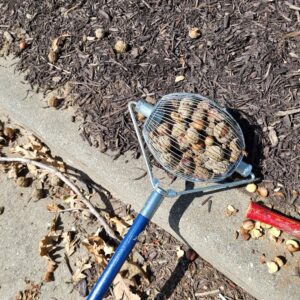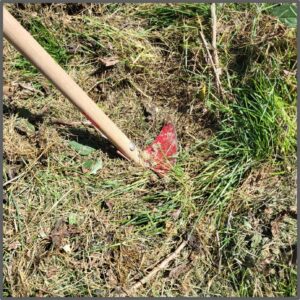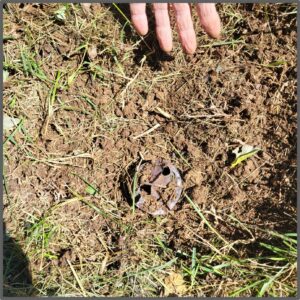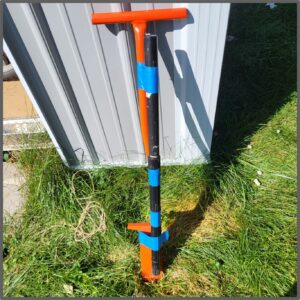We thank Ray Major, Forrester and Trees from Seed Facebook Page Editor, for sharing this valuable information.
Anyone wanting to plant a shade tree or ornamental tree on their property must decide whether to purchase a nursery-grown tree or plant their own from seed. Here are some reasons we recommend direct sowing of tree seeds, which is done in autumn.
Direct Seeding…
Produces superior trees. The trees are healthier, grow faster on an annual basis over time, and live longer. They are always planted correctly. There are no short- or long-term transplanting injuries, and no transplant shock. They outgrow transplants in a few years.
Is accessible to anyone. Everyone, including those of limited means, the disabled, the elderly, children, and those unaccustomed to physical labor, can direct seed a tree. The labor is within the ability of almost everyone, and the cost is minimal.
Is economical. It requires no nursery, no transportation, no transplanting labor, no digging of large holes, no heavy lifting of plant material, no transplant after-care, no staking, and no watering.
Produces more trees per unit expenditure. Far more trees can be planted within a given budget and more of the budget can be set aside for ongoing tree care such as protective cages and proper pruning.
“An acorn in a pot is like a tiger in a cage.“ —Walt Sinnfield
Oaks and many other tree species produce immense root systems very quickly. They become rootbound if grown in pots and often suffer great damage, slowed growth, and shortened lives when grown in containers. Continual repotting to larger and larger containers is called for and becomes increasingly difficult. In contrast, trees grown directly in place on suitable soils develop deep, wide-spreading root systems early on, which are essential for long term growth and health.
Make It an Oak
Native oaks are the top suppliers of caterpillars for birds to feed their young and insects to nourish the web of life. Every neighborhood should have some, sited where they can grow to their full magnificence.
The two subgenera of oaks common in Indiana—red oaks and white oaks—are distinct from each other in germination requirements and habits.
Red oak acorns require two years to develop and ripen. They must overwinter or be artificially cold-moist stratified to break dormancy and produce roots the spring following ripening. If red oak acorns are stored dry and warm over the winter, the way one would store seed corn, they gradually lose viability and will not germinate.
White oak acorns mature in a single season. They produce roots immediately in the fall as soon as conditions are moist. They cannot be stored over winter. If they are stored warm and dry like seed corn, they will desiccate and die within a few weeks. They are difficult to stratify, so should be planted in the fall, preferably direct-seeded in the place where they are to grow, with protection from animals as needed.
Red Oak Group
Northern Red Oak (Quercus rubra)
Black Oak (Q. velutina)
Scarlet Oak (Q. coccinea)
Shingle Oak (Q. imbricaria)
Shumard Oak (Q. shumardii)
Cherrybark Oak (Q. pagoda)
Southern Red Oak (Q. falcata)
Pin Oak (Q. palustris)
Northern Pin Oak (Q. elipsoides)
Blackjack Oak (Q. marilandica)
White Oak Group
White Oak (Quercus alba)
Bur Oak (Q. macrocarpa)
Chestnut Oak (Q. montana)
Chinkapin Oak (Q. muehlenbergii)
Swamp White Oak (Q. bicolor)
Swamp Chestnut Oak (Q.michauxii)
Overcup Oak (Q. lyrata)
Post Oak (Q. stellata)
Dwarf Chinkapin Oak (Q. prinoides)
Nuts Stratified Nature’s Way
Large tree seeds, acorns, and nuts can be stratified underground in well drained, ventilated, rodent proof containers. A constructed germination box is ideal, but suitable containers can also be devised from buckets, plastic berry boxes, coffee cans, and pill bottles. Perforate both the top and bottom of the container with small holes no larger than one-half inch in diameter to facilitate good drainage and air exchange, but small enough to keep rodents out. Be sure to label the seeds by species, collection date, and stratification date.
- Use a well draining, rodent-proof container.
- Add a layer of acorns.
- Cover acorns with loose soil, sand, or leaf mold.
- Seal container with hardware cloth.
- Cover container with loose soil, sand, leaf mold.
Check for early germination as the end of the stratification period approaches. Many species will germinate in cold damp conditions when the stratification process is complete. They don’t depend upon warm weather to begin germination.
When the first tiny roots appear, plant them, unless the ground is still frozen. Don’t wait until warm weather.
Protecting Tree Seedlings
Acorns, nuts, and other large seeds are subject to predation by rodents and deer, endangering tender seedlings as they emerge. Here are several common methods of protecting the young trees:
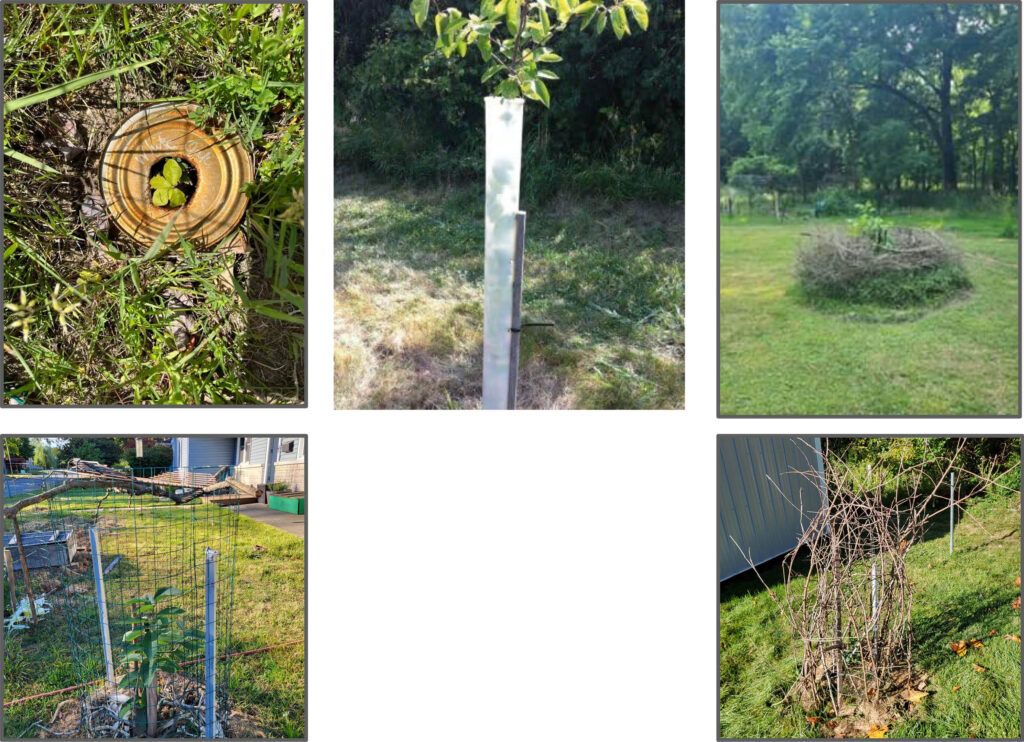
Clockwise from left: Droste can, plastic tree guard, dead hedging. fencing with brush, tight fencing. Click to enlarge image.
The Droste can. The can protects both seeds and newly emerged seedlings.
Plastic tree guards. These are relatively inexpensive and vary in quality and effectiveness.
Dead hedging. Using cut brush as a barrier to deer is inexpensive and uses materials at hand. Skill and labor are required to build effective dead hedges.
Live hedging. Live hedges can be grown and tended to protect tree saplings. They require skill and regular maintenance but are highly effective against deer and larger browsers such as elk.
Tight fencing. A good size is 3 x 4-inch welded wire, and 60- or 72-inch height is best, supported by a 7-foot agricultural tee post. These materials are expensive but highly effective.
Sample Home Project
This tree planting project is at the end of its first growing season. It consists of 20 trees of eight species, black cherry, big tooth aspen, persimmon, yellowwood, redbud, river birch, sycamore, and Kentucky coffeetree. All the seed for this young grove of trees was gathered from street gutters and sidewalks in an urban neighborhood.
Each planting site was prepared by cutting a small square of sod and sowing a generous number of seeds directly into the soil. None of the seeds received any special preparation except the coffeetree and the yellowwood, which were scarified. About the middle of June the strongest two seedlings were chosen in each site and the others were cut. In August each site was thinned to the strongest seedling.
All twenty seedlings are well established, healthy, and have required little care other than weeding and fencing. They were watered in dry weather, not to keep them alive as would be the case with transplants, but to allow them to continue steady growth through the summer.
Because of the immense deer browse pressure in the neighborhood, all of the seedlings are fenced. Fencing would also be necessary if nursery stock were used.
Had this project been planted with small nursery stock it would have cost about $600 plus labor. This would be a substantial cost for many households wanting to have shade and flowering trees. These seed-planted trees will quickly outgrow two-year potted nursery stock that might otherwise have been used.



